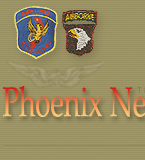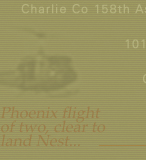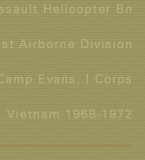 |
 |
 |
 |
|
For best results when using this website, your browser should allow popups and javascript
|
Hamburger Hill Footnoted references are in our complete Unit History archive... On May 8, 1969, the Phoenix became a part of the assault on Dong Ap Bia, also known as "Hamburger Hill" in the Ashau Valley. The mountain was called Ap Bia by the local Montagard tribesman and it meant, “ the mountain of the crouching beast”.79 The assault into the Ashau Valley was a part of “Operation Apache Snow. This operation was to be a direct challenge to the North Vietnamese Army. The Ashau Valley was a stronghold for the North Vietnamese Army’s 29th Infantry Regiment and had been used as a base for launching the Tet attack against the city of Hue in 1968. Pickup zone activities near Firebase Blaze, YD 539023 caused the only difficulties. Blaze was five hundred meters by a thousand meters and was twenty kilometers south of Ap Bia Mountain.78 The pathfinder personnel were confused by the near simultaneous arrival of the Phoenix aircraft and the aircraft from a unit of the 101st Aviation Battalion. The pathfinder personnel misdirected the Phoenix aircraft and the aircraft returned later to the same pickup zone using more fuel than was planned. Also five of the Phoenix aircraft were separated from the main body by a river that ran through the pickup zone. The infantry troops had to wade across the river to load into the aircraft.54 The Phoenix was the first to land in LZ 3 with the initial insertion. They carried soldiers of the 1st ARVN Division. The Army of South Vietnam units were 4/1 and 2/1 ARVN.83 Major Jenkins lead the first flight in with Roy Miller as the leader of the second flight. It was a "two shipper”-landing zone which meant that it was large enough for two aircraft to land at the same time. Later "B' Company received enemy fire in that landing zone. The Phoenix's first hot LZ was an ARVN insertion on Tiger Mountain. Roy Miller's aircraft was shot up and he had to land in the A Shau Valley floor on the third trip into the landing zone. His co-pilot was Paul Michal who was a prior Navy vet and was one of the "old" men of the Second platoon at the ripe age of 28. He was wounded and Major Jenkins landed with them and took Paul to Camp Eagle for medical treatment. Roy's crew chief, Duncan, got in the right seat and they flew aircraft 67-17616 back to the Phoenix Nest. They had taken four rounds in the fuel cell but it self-sealed at about 250 pounds of fuel. A couple of rounds came through the crewchief's well. There were several hits through the console and the right side door. One of the rounds had hit Paul. He lost part of his left hand and was sent home. Terry Hilt was the door gunner on 616 and got the first confirmed kill in the unit. 616 had a red Chinese hat on the fuselage behind the door to signify the event. Roy got some sheet metal fragments in his right leg but didn't realize it until that night in the Phoenix club. He poured some whiskey on the wound, took two aspirin and flew the next morning. Also during the assault, Specialist Stuart Brittman, the crewchief for 67-17597 was wounded. The 101st Division withdrew from “Hamburger Hill” on May 20th but would return several times to the hill during the summer of 1969 to challenge the North Vietnamese Army.4 The Phoenix lost one aircraft at Hamburger Hill. It had a short shaft failure and was being evacuated by a Chinook (CH-47). Unfortunately the Chinook crew dragged the aircraft through the trees resulting in more damage.26 |